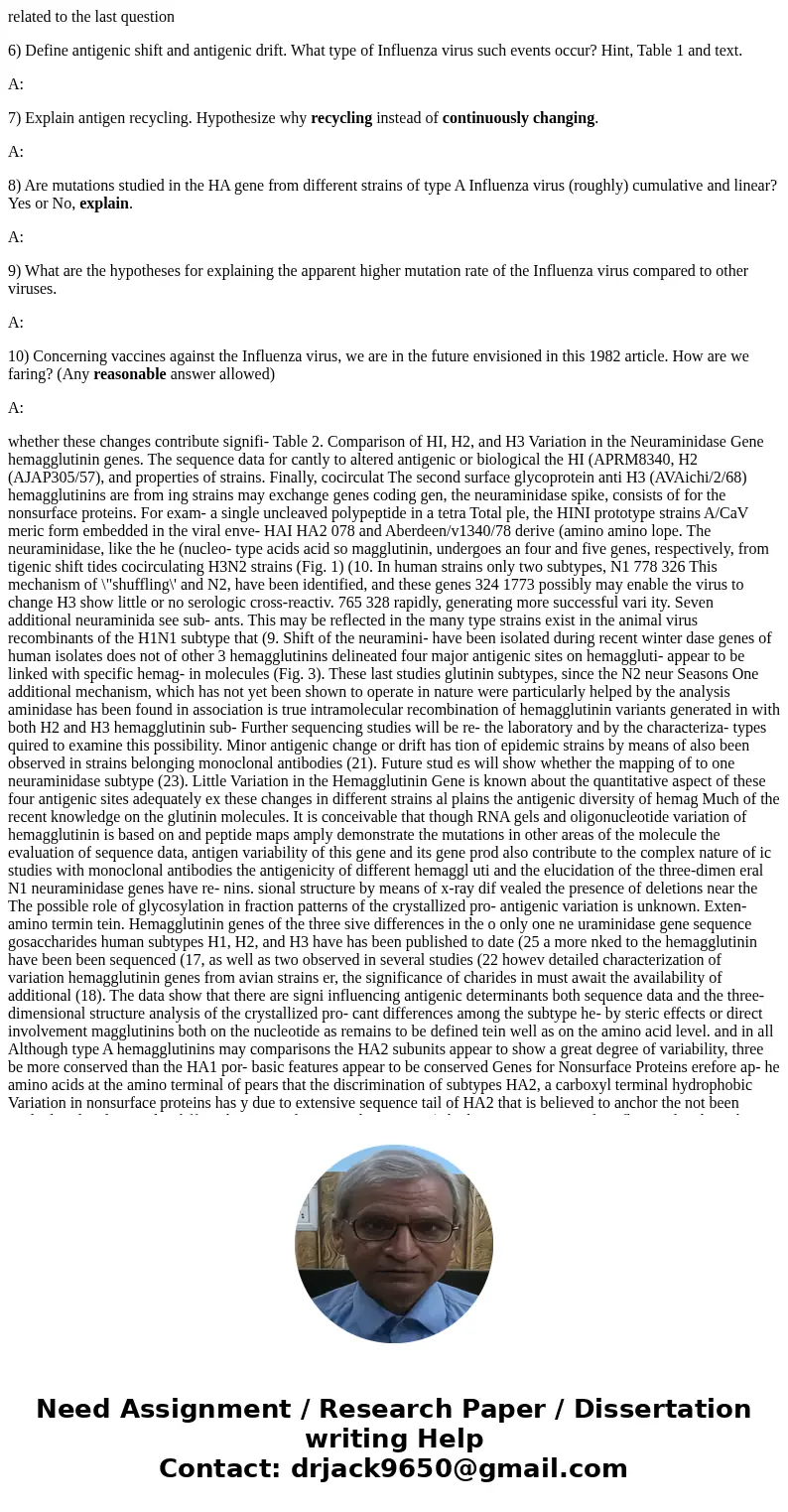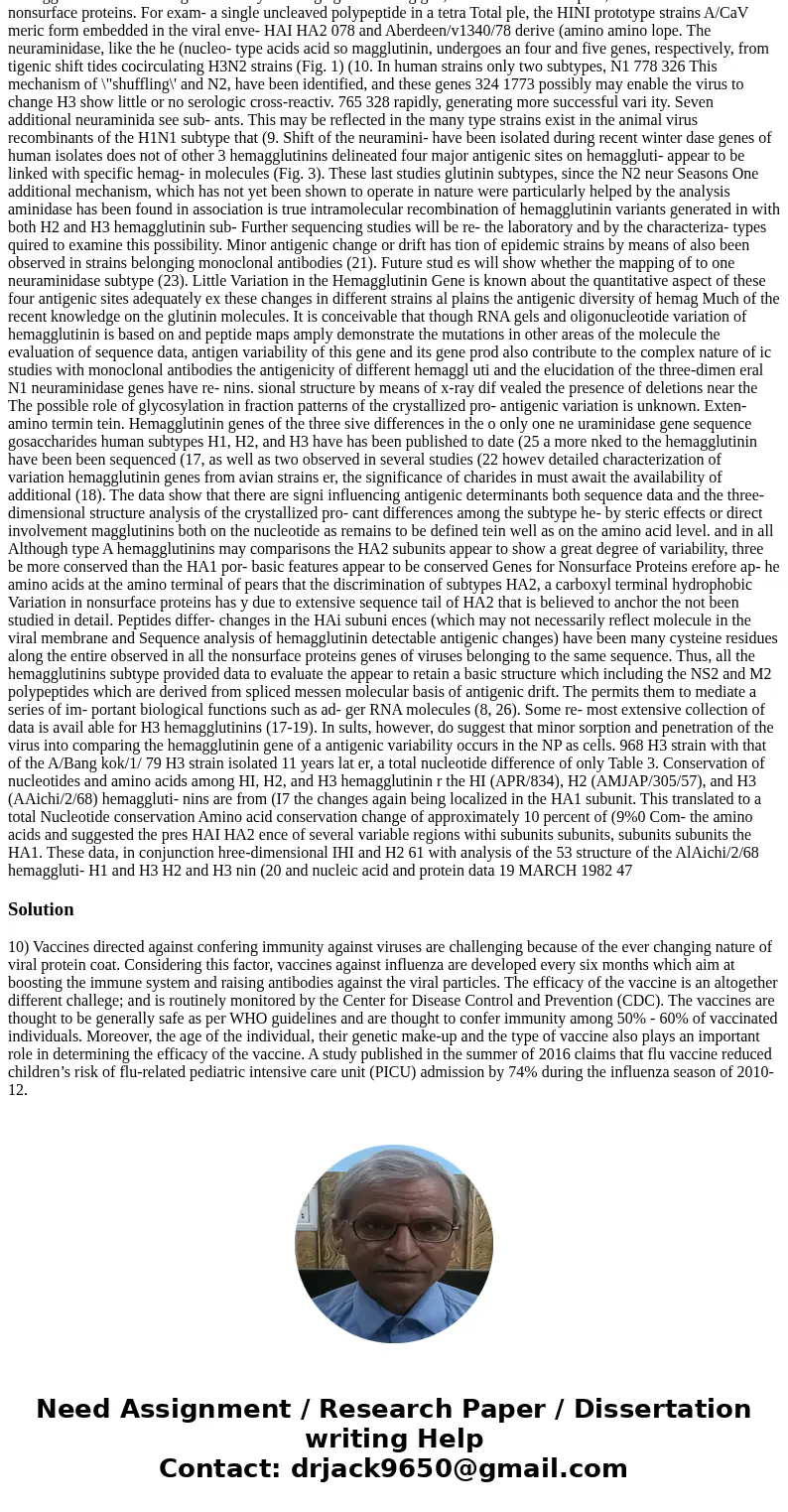related to the last question 6 Define antigenic shift and an
related to the last question
6) Define antigenic shift and antigenic drift. What type of Influenza virus such events occur? Hint, Table 1 and text.
A:
7) Explain antigen recycling. Hypothesize why recycling instead of continuously changing.
A:
8) Are mutations studied in the HA gene from different strains of type A Influenza virus (roughly) cumulative and linear? Yes or No, explain.
A:
9) What are the hypotheses for explaining the apparent higher mutation rate of the Influenza virus compared to other viruses.
A:
10) Concerning vaccines against the Influenza virus, we are in the future envisioned in this 1982 article. How are we faring? (Any reasonable answer allowed)
A:
whether these changes contribute signifi- Table 2. Comparison of HI, H2, and H3 Variation in the Neuraminidase Gene hemagglutinin genes. The sequence data for cantly to altered antigenic or biological the HI (APRM8340, H2 (AJAP305/57), and properties of strains. Finally, cocirculat The second surface glycoprotein anti H3 (AVAichi/2/68) hemagglutinins are from ing strains may exchange genes coding gen, the neuraminidase spike, consists of for the nonsurface proteins. For exam- a single uncleaved polypeptide in a tetra Total ple, the HINI prototype strains A/CaV meric form embedded in the viral enve- HAI HA2 078 and Aberdeen/v1340/78 derive (amino amino lope. The neuraminidase, like the he (nucleo- type acids acid so magglutinin, undergoes an four and five genes, respectively, from tigenic shift tides cocirculating H3N2 strains (Fig. 1) (10. In human strains only two subtypes, N1 778 326 This mechanism of \"shuffling\' and N2, have been identified, and these genes 324 1773 possibly may enable the virus to change H3 show little or no serologic cross-reactiv. 765 328 rapidly, generating more successful vari ity. Seven additional neuraminida see sub- ants. This may be reflected in the many type strains exist in the animal virus recombinants of the H1N1 subtype that (9. Shift of the neuramini- have been isolated during recent winter dase genes of human isolates does not of other 3 hemagglutinins delineated four major antigenic sites on hemaggluti- appear to be linked with specific hemag- in molecules (Fig. 3). These last studies glutinin subtypes, since the N2 neur Seasons One additional mechanism, which has not yet been shown to operate in nature were particularly helped by the analysis aminidase has been found in association is true intramolecular recombination of hemagglutinin variants generated in with both H2 and H3 hemagglutinin sub- Further sequencing studies will be re- the laboratory and by the characteriza- types quired to examine this possibility. Minor antigenic change or drift has tion of epidemic strains by means of also been observed in strains belonging monoclonal antibodies (21). Future stud es will show whether the mapping of to one neuraminidase subtype (23). Little Variation in the Hemagglutinin Gene is known about the quantitative aspect of these four antigenic sites adequately ex these changes in different strains al plains the antigenic diversity of hemag Much of the recent knowledge on the glutinin molecules. It is conceivable that though RNA gels and oligonucleotide variation of hemagglutinin is based on and peptide maps amply demonstrate the mutations in other areas of the molecule the evaluation of sequence data, antigen variability of this gene and its gene prod also contribute to the complex nature of ic studies with monoclonal antibodies the antigenicity of different hemaggl uti and the elucidation of the three-dimen eral N1 neuraminidase genes have re- nins. sional structure by means of x-ray dif vealed the presence of deletions near the The possible role of glycosylation in fraction patterns of the crystallized pro- antigenic variation is unknown. Exten- amino termin tein. Hemagglutinin genes of the three sive differences in the o only one ne uraminidase gene sequence gosaccharides human subtypes H1, H2, and H3 have has been published to date (25 a more nked to the hemagglutinin have been been sequenced (17, as well as two observed in several studies (22 howev detailed characterization of variation hemagglutinin genes from avian strains er, the significance of charides in must await the availability of additional (18). The data show that there are signi influencing antigenic determinants both sequence data and the three-dimensional structure analysis of the crystallized pro- cant differences among the subtype he- by steric effects or direct involvement magglutinins both on the nucleotide as remains to be defined tein well as on the amino acid level. and in all Although type A hemagglutinins may comparisons the HA2 subunits appear to show a great degree of variability, three be more conserved than the HA1 por- basic features appear to be conserved Genes for Nonsurface Proteins erefore ap- he amino acids at the amino terminal of pears that the discrimination of subtypes HA2, a carboxyl terminal hydrophobic Variation in nonsurface proteins has y due to extensive sequence tail of HA2 that is believed to anchor the not been studied in detail. Peptides differ- changes in the HAi subuni ences (which may not necessarily reflect molecule in the viral membrane and Sequence analysis of hemagglutinin detectable antigenic changes) have been many cysteine residues along the entire observed in all the nonsurface proteins genes of viruses belonging to the same sequence. Thus, all the hemagglutinins subtype provided data to evaluate the appear to retain a basic structure which including the NS2 and M2 polypeptides which are derived from spliced messen molecular basis of antigenic drift. The permits them to mediate a series of im- portant biological functions such as ad- ger RNA molecules (8, 26). Some re- most extensive collection of data is avail able for H3 hemagglutinins (17-19). In sults, however, do suggest that minor sorption and penetration of the virus into comparing the hemagglutinin gene of a antigenic variability occurs in the NP as cells. 968 H3 strain with that of the A/Bang kok/1/ 79 H3 strain isolated 11 years lat er, a total nucleotide difference of only Table 3. Conservation of nucleotides and amino acids among HI, H2, and H3 hemagglutinin r the HI (APR/834), H2 (AMJAP/305/57), and H3 (AAichi/2/68) hemaggluti- nins are from (I7 the changes again being localized in the HA1 subunit. This translated to a total Nucleotide conservation Amino acid conservation change of approximately 10 percent of (9%0 Com- the amino acids and suggested the pres HAI HA2 ence of several variable regions withi subunits subunits, subunits subunits the HA1. These data, in conjunction hree-dimensional IHI and H2 61 with analysis of the 53 structure of the AlAichi/2/68 hemaggluti- H1 and H3 H2 and H3 nin (20 and nucleic acid and protein data 19 MARCH 1982 47Solution
10) Vaccines directed against confering immunity against viruses are challenging because of the ever changing nature of viral protein coat. Considering this factor, vaccines against influenza are developed every six months which aim at boosting the immune system and raising antibodies against the viral particles. The efficacy of the vaccine is an altogether different challege; and is routinely monitored by the Center for Disease Control and Prevention (CDC). The vaccines are thought to be generally safe as per WHO guidelines and are thought to confer immunity among 50% - 60% of vaccinated individuals. Moreover, the age of the individual, their genetic make-up and the type of vaccine also plays an important role in determining the efficacy of the vaccine. A study published in the summer of 2016 claims that flu vaccine reduced children’s risk of flu-related pediatric intensive care unit (PICU) admission by 74% during the influenza season of 2010-12.


 Homework Sourse
Homework Sourse